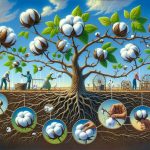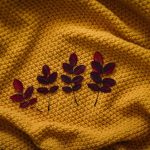Are you curious about how cotton fabric is made? Look no further! In this guide, we’ll walk you through the entire production process.
You’ll learn how cotton is cultivated and harvested, how the fibers are separated from the seeds, and how they are spun into yarn.
We’ll also explore the methods used to create the fabric structure, add color and enhancements, and prepare the fabric for market.
Get ready to dive into the fascinating world of cotton fabric production!
Table of Contents
Cultivating and Harvesting Cotton
To begin cultivating and harvesting cotton, you’ll need to prepare the soil and plant the cotton seeds. Proper irrigation methods are crucial to ensure the cotton plants receive enough water throughout their growth cycle. Depending on the region and climate, different irrigation techniques can be used, such as flood irrigation or drip irrigation. Flood irrigation involves flooding the field with water, while drip irrigation delivers water directly to the roots using a network of tubes and emitters. Both methods have their advantages and disadvantages, so it’s important to choose the one that suits your specific needs.
In addition to irrigation, pest control is another important aspect of cotton cultivation. Cotton plants are susceptible to various pests, such as bollworms, aphids, and whiteflies. To protect the crop from these pests, farmers can use different pest control methods. Chemical pesticides are commonly used, but there’s growing concern about their environmental impact. Alternatively, integrated pest management (IPM) techniques can be employed, which involve a combination of biological, cultural, and chemical control methods. These methods aim to minimize the use of harmful chemicals while still effectively managing pests.
Ginning: Separating Cotton Fibers From Seeds
To separate the cotton fibers from the seeds, you’ll need to use a process called ginning. Ginning plays a crucial role in the cotton fabric production process, as it ensures that only the high-quality cotton fibers are used.
Here is a step-by-step guide to understanding the ginning process and its impact on cotton quality:
-
Cotton gin technology: Modern ginning machines have revolutionized the cotton industry. These machines use rotating saws or teeth to remove the cotton fibers from the seeds. The cotton is fed into the gin, where the seeds are separated from the fibers through a series of mechanical actions.
-
Improved efficiency: Ginning machines have significantly increased the speed and efficiency of separating cotton fibers from seeds. This advancement has allowed cotton farmers to process larger quantities of cotton in a shorter amount of time.
-
Reduced contamination: Ginning helps remove impurities such as dirt, leaves, and stems from the cotton fibers. This process ensures that the cotton fibers are clean and ready for further processing.
-
Enhanced cotton quality: The ginning process has a direct impact on the quality of cotton. By separating the fibers from the seeds, ginning helps produce longer, stronger, and more uniform cotton fibers. This results in higher-quality cotton fabrics that are softer, more durable, and better suited for textile production.
Spinning: Transforming Fibers Into Yarn
Now let’s talk about spinning, where the fibers are transformed into yarn.
In this process, you need to consider the fiber selection criteria, which involves choosing the right type of cotton and assessing its quality.
Additionally, different spinning techniques will be explained, giving you an understanding of how the fibers are twisted together to create yarn.
Lastly, we’ll discuss the importance of yarn quality control to ensure the final product meets the desired standards.
Fiber Selection Criteria
When selecting fibers for spinning into yarn, it’s important to consider various criteria. These criteria will help ensure that the fabric produced is durable and of high quality.
Here are four key factors to consider in the fiber selection process:
-
Fiber Sourcing: It’s crucial to choose fibers that are sourced responsibly and sustainably. Opting for fibers that are grown and harvested using eco-friendly practices will contribute to the overall sustainability of the fabric production process.
-
Fabric Durability: The selected fibers should possess the necessary strength and resilience to withstand regular wear and tear. This will ensure that the resulting fabric is long-lasting and can withstand repeated use.
-
Fiber Length: Longer fibers tend to produce stronger and more durable yarn. Therefore, it’s important to select fibers with optimum length to ensure the desired fabric quality.
-
Fiber Fineness: The fineness of the fibers affects the softness and comfort of the fabric. Finer fibers tend to create smoother and more luxurious fabrics, while coarser fibers may result in a rougher texture.
Spinning Techniques Explained
Once you have selected the appropriate fibers based on the criteria mentioned earlier, it’s time to delve into the spinning techniques that will transform these fibers into yarn.
There are two main spinning techniques used in the cotton fabric production process: ring spinning and open end spinning.
Ring spinning is the traditional method that produces high-quality yarn. It involves drafting the fibers, which means stretching and aligning them, and then twisting them into yarn using a spinning frame. This process creates strong and smooth yarn suitable for fine fabrics.
On the other hand, open end spinning is a more modern technique that’s faster and more cost-effective. It involves feeding the fibers into a rotor, where they’re rapidly twisted and wrapped around a central core. The resulting yarn is less uniform and may have a rougher texture, making it suitable for coarser fabrics.
Both ring spinning and open end spinning have their advantages and are used depending on the desired outcome and production requirements.
Yarn Quality Control
To ensure the production of high-quality yarn, it’s essential to implement effective yarn quality control measures during the spinning process. Here are four key steps to consider:
-
Yarn strength testing: This involves evaluating the tensile strength of the yarn to determine its ability to withstand stress and strain during weaving or knitting. It helps identify weak spots and ensures the yarn meets the required strength standards.
-
Yarn contamination analysis: This step involves inspecting the yarn for any foreign matter or impurities that may affect its quality. It includes visual inspection, microscopic examination, and using specialized equipment to detect and remove any contaminants.
-
Twist analysis: The twist level of the yarn affects its strength, appearance, and performance. By analyzing the twist, manufacturers can ensure consistency and uniformity in the yarn’s properties.
-
Monitoring yarn parameters: This includes checking and controlling various parameters such as yarn count, evenness, and moisture content to ensure the yarn meets the desired specifications.
Weaving or Knitting: Creating the Fabric Structure
Now let’s talk about the differences between weaving and knitting and the techniques used to create fabric.
Weaving involves interlacing yarns at right angles to form a stable and structured fabric, while knitting uses loops of yarn to create a more flexible and stretchy fabric.
Understanding these techniques is essential for understanding the fabric production process.
Weaving Vs. Knitting: Differences
When comparing weaving and knitting, you may notice distinct differences in how the fabric structure is created. Here are four key points that highlight the dissimilarities:
-
Weaving techniques: Weaving involves interlacing two sets of yarns, known as warp and weft, at right angles to create a stable fabric. The warp threads are fixed vertically on a loom, while the weft threads are passed horizontally through them.
-
Knitting patterns: Knitting, on the other hand, uses a single set of yarn to create interlocking loops. The loops are formed by manipulating the yarn with knitting needles or machines, resulting in a stretchy and flexible fabric.
-
Fabric characteristics: Weaving produces a flat and stable fabric with clearly defined patterns, while knitting creates a more textured and elastic fabric that conforms to the body’s shape.
-
Versatility: Weaving allows for intricate designs and complex patterns, while knitting offers endless possibilities for creating intricate textures and patterns, including cables, lace, and colorwork.
Understanding these differences can help you appreciate the unique qualities of woven and knitted fabrics and choose the right fabric for your project.
Techniques for Fabric Creation
Choose the appropriate technique for fabric creation, whether weaving or knitting, to create the desired fabric structure. Both weaving and knitting are commonly used methods in fabric production, each with its own advantages and characteristics. Weaving involves interlacing yarns at right angles to form a stable fabric, while knitting creates fabric by interlocking loops of yarn. To help you understand the differences between the two techniques, here is a comparison table:
| Weaving | Knitting |
|---|---|
| More stable and structured fabric | More stretchable and flexible fabric |
| Requires a loom and warp and weft yarns | Requires knitting needles and yarn |
| Suitable for creating intricate patterns | Suitable for creating seamless garments |
When it comes to fabric dyeing techniques, both woven and knitted fabrics can be dyed using various methods, such as direct dyeing, vat dyeing, or pigment dyeing. To promote sustainable fabric production, it is important to choose eco-friendly dyeing processes and consider using organic or natural dyes whenever possible.
Bleaching and Dyeing: Adding Color and Enhancements
To add color and enhancements to cotton fabric, you can begin by bleaching and dyeing the material. This step allows you to create vibrant and eye-catching designs that align with the latest color trends. Additionally, there are sustainable dyeing techniques available that minimize the environmental impact of the process.
Here is a step-by-step guide to bleaching and dyeing cotton fabric:
-
Preparing the fabric: Start by thoroughly washing and preparing the cotton fabric. This removes any impurities and ensures that the dye adheres evenly.
-
Bleaching: If you want to achieve a pure white fabric or create a blank canvas for vibrant colors, bleaching is necessary. This step removes any natural color or stains from the fabric.
-
Dyeing: Choose a dye that suits your desired color and follow the instructions provided. There are various dyeing techniques available, such as immersion dyeing or tie-dyeing, to achieve different effects.
-
Finishing: After dyeing, it’s important to rinse and wash the fabric to remove excess dye. Then, dry and press the fabric to finish the process.
Finishing and Quality Control: Preparing the Fabric for Market
How can you ensure the cotton fabric is ready for the market through finishing and quality control?
Fabric finishing is the final step in the cotton fabric production process. It involves various treatments and processes to enhance the fabric’s appearance, texture, and performance.
Quality control plays a crucial role in ensuring that the fabric meets the desired standards and is ready for the market.
Fabric finishing includes processes such as singeing, which removes protruding fibers from the fabric surface, and mercerizing, which improves the fabric’s luster and strength. Other finishing techniques include calendering, which adds smoothness and sheen, and coating, which adds special properties like water resistance.
Fabric inspection is an essential part of the finishing process. It involves a detailed examination of the fabric to identify any defects or flaws. This inspection ensures that the fabric meets the required standards of quality and appearance. Defects such as holes, stains, or uneven dyeing can be detected and rectified before the fabric is sent to the market.
By implementing proper fabric finishing techniques and conducting thorough fabric inspections, you can ensure that the cotton fabric is of high quality and ready for the market.
This attention to detail and quality control will help you deliver a superior product to your customers.
Frequently Asked Questions
What Are Some Common Challenges Faced During the Cultivation and Harvesting of Cotton?
You’ll face cultivation challenges like pests, diseases, and unpredictable weather. Harvesting challenges include labor-intensive picking and handling delicate cotton bolls. Overcoming these obstacles is crucial for successful cotton production.
How Does the Ginning Process Impact the Quality of the Cotton Fibers?
The ginning process greatly impacts the quality of cotton fibers. It is important to ensure the ginning quality as it determines the cleanliness and strength of the fibers, which ultimately affects the fabric’s quality.
What Are the Different Types of Spinning Techniques Used in the Cotton Fabric Production Process?
There are different spinning techniques used in cotton fabric production. These techniques rely on the properties of cotton fibers to create different types of yarns, such as ring spinning and open-end spinning.
Can You Explain the Difference Between Weaving and Knitting in Terms of Creating Fabric Structure?
Weaving and knitting are two techniques used to create fabric structure. Weaving involves crossing threads over and under each other, while knitting uses loops to interlock. Weaving produces a more stable fabric, while knitting allows for more stretch.
What Are Some Environmentally Friendly Techniques or Alternatives Used in the Bleaching and Dyeing Process of Cotton Fabric Production?
To make the bleaching and dyeing process of cotton fabric production more environmentally friendly, sustainable bleaching techniques and eco-friendly dyeing methods are used. These alternatives help reduce the negative impact on the environment.
- How Does Ring Spun Cotton Affect Garment Fit and Shape Retention? - August 13, 2024
- What Are the Challenges in Producing Ring Spun Cotton? - August 13, 2024
- Is Ring Spun Cotton Suitable for Plus-Size Clothing? - August 13, 2024




